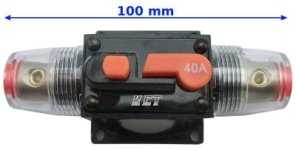samsavvas
100 W
Hi Folks,
I've searched the forum and haven't been able to find a specific solution to this so here's my situation. I have my cargo bike set up with an EM3ev 36v BBS drive and frame battery (with low current on-off switch built into the case). I also have a 36v/10ah unswitched Ping battery that I'd like to carry as an alternative backup for longer trips. I know that I can simply connect both batteries with a common ground and use a single pole, double throw switch on the other side, a bit like the 'multiple battery' schematic that Ping has here: http://www.pingbattery.com/content/wiringguide.pdf
However I'm aware that the controller on the BBS is in the motor housing so I'm guessing that any power-bus dual (i.e.; 'A/B')battery switch is going to have to handle what I think is called a 'capacitive load' - that is, potential for massive sparks. So will I need additional 'anti-spark' switches for each battery to protect the double throw switch?
As an alternative to trying to switch from one battery to another, could I simply unplug one battery from the motor's power cable and then plug the other in? Will I still need individual 'on/off' switches for each battery in this arrangement as well (the Ping comes without such a switch, the EM3ev frame battery has a low current 'on/off' - not quite sure how it works)?
Thinking about a switched arrangement is all getting a bit complicated - is there a simple solution? Should I just buy a second EM3ev frame battery and use the 'swapped connector' approach? A switch sounds like a much 'cleaner' solution but...
I'd appreciate any ideas, links and experiences using such a set-up. A schematic would be great!
Thanks,
Sam.
I've searched the forum and haven't been able to find a specific solution to this so here's my situation. I have my cargo bike set up with an EM3ev 36v BBS drive and frame battery (with low current on-off switch built into the case). I also have a 36v/10ah unswitched Ping battery that I'd like to carry as an alternative backup for longer trips. I know that I can simply connect both batteries with a common ground and use a single pole, double throw switch on the other side, a bit like the 'multiple battery' schematic that Ping has here: http://www.pingbattery.com/content/wiringguide.pdf
However I'm aware that the controller on the BBS is in the motor housing so I'm guessing that any power-bus dual (i.e.; 'A/B')battery switch is going to have to handle what I think is called a 'capacitive load' - that is, potential for massive sparks. So will I need additional 'anti-spark' switches for each battery to protect the double throw switch?
As an alternative to trying to switch from one battery to another, could I simply unplug one battery from the motor's power cable and then plug the other in? Will I still need individual 'on/off' switches for each battery in this arrangement as well (the Ping comes without such a switch, the EM3ev frame battery has a low current 'on/off' - not quite sure how it works)?
Thinking about a switched arrangement is all getting a bit complicated - is there a simple solution? Should I just buy a second EM3ev frame battery and use the 'swapped connector' approach? A switch sounds like a much 'cleaner' solution but...
I'd appreciate any ideas, links and experiences using such a set-up. A schematic would be great!
Thanks,
Sam.


